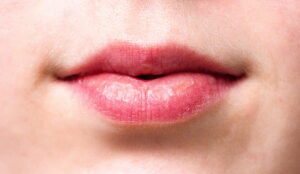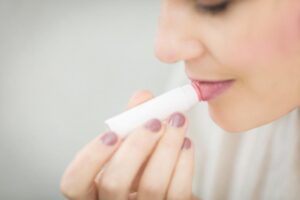
As the temperatures start to drop, more and more of us will start reaching for lip balm as our lips get chapped and dried out. But what is the science behind how these products work?
Why Your Lips Get Chapped

Chapped lips, or cheilitis in medical terms, can occur from dehydration, sun exposure, vitamin deficiencies, or cold/dry weather. The skin on your lips is different and more sensitive than other parts of your body. As “transitional skin,” lip skin lacks a stratum corneum or a tough outer layer, giving it its red appearance; lip skin is even four times thinner than the skin on the rest of your body and lacks sweat and oil glands. Moreover, as external skin it receives no protection from the environment and licking your lips can even further dry them out because your saliva contains enzymes that can break down the fats and proteins in your lips.
Components of Lip Balm

When lips are chapped, dermatologists recommend using a non-irritating lip balm — along with using SPF, staying hydrated, avoiding metal, using a humidifier, and avoiding licking or biting your lips. Although meant to relieve dryness, lip balms don’t absorb into the skin to moisturize the same way a body lotion does. On the contrary, these products are occlusive moisturizers that form a barrier sitting on top of lips in order to lock in moisture. If the balm is rubbed away through talking or eating, your lips can dry out once again. Ingredients that heal chapped lips and help lock in moisture include castor seed oil, ceramides, dimethicone, hemp seed oil, mineral oil, petroleum, and shea butter. Dermatologists also recommend using hypoallergenic and fragrance free products on this sensitive area of your body. Along these lines, many ingredients can be mildly irritating to the skin of your lips or trigger allergic reactions in some. Some of these commonly include camphor, eucalyptus, flavoring, fragrance, lanolin, menthol, salicylic acid, propyl gallate, phenol, and oxybenzone. Products claiming to “exfoliate” or “plump” your lips are also likely to irritate them. Any discomfort upon application of lip balm such as tingling, burning, or stinging, is a sign that it is actually irritating your skin instead of healing your lips.
Can You Use Too Much Lip Balm?

When your lips are dry, you may find yourself constantly reaching for lip balm throughout the day and wondering if it’s even helping. Dermatologists actually recommend applying lip balm twice a day — once in the morning and once before bed — likely way less frequently than the general population uses these products. Some consumers have additionally discussed uncontrollable urges to apply lip balm up to 300 times a day through online forums such as Lip Balm Anonymous. However, as lip balm contains no physically addictive ingredients, this is classified as a behavioral addiction or a bad habit that may be broken (sometimes with assistance). Additionally, while there are conspiracy theories about popular lip balm products containing drying ingredients to encourage frequent purchases, experts have shown these claims to be exaggerated. While some dermatologists claim that lip balm overuse may create a dependency on the aided moisturization, most agree that lip balm use generally does not create a dependency. It is also worth noting that in addition to being irritating, flavors and fragrances may cause you to lick your lip balm unconsciously throughout the day, removing the product, depositing saliva, further drying out your lips, and necessitating reapplication — further supporting the avoidance of these ingredients. Understanding the science contributing to your chapped lips and the roles of different ingredients can help consumers make informed decisions about the lip balm they purchase and how they apply it to their skin.
Peer Editor: Mikayla Feldbauer